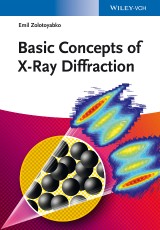Details

Basic Concepts of X-Ray Diffraction
1. Aufl.
|
70,99 € |
|
| Verlag: | Wiley-VCH |
| Format: | EPUB |
| Veröffentl.: | 10.02.2014 |
| ISBN/EAN: | 9783527681181 |
| Sprache: | englisch |
| Anzahl Seiten: | 312 |
DRM-geschütztes eBook, Sie benötigen z.B. Adobe Digital Editions und eine Adobe ID zum Lesen.
Beschreibungen
Authored by a university professor deeply involved in X-ray diffraction-related research, this textbook is based on his lectures given to graduate students for more than 20 years. It adopts a well-balanced approach, describing basic concepts and experimental techniques, which make X-ray diffraction an unsurpassed method for studying the structure of materials.<br> <br> Both dynamical and kinematic X-ray diffraction is considered from a unified viewpoint, in which the dynamical diffraction in single-scattering approximation serves as a bridge between these two parts. The text emphasizes the fundamental laws that govern the interaction of X-rays with matter, but also covers in detail classical and modern applications, e.g., line broadening, texture and strain/stress analyses, X-ray mapping in reciprocal space, high-resolution X-ray diffraction in the spatial and wave vector domains, X-ray focusing, inelastic and time-resolved X-ray scattering. This unique scope, in combination with otherwise hard-to-find information on analytic expressions for simulating X-ray diffraction profiles in thin-film heterostructures, X-ray interaction with phonons, coherent scattering of Mossbauer radiation, and energy-variable X-ray diffraction, makes the book indispensable for any serious user of X-ray diffraction techniques.<br> <br> Compact and self-contained, this textbook is suitable for students taking X-ray diffraction courses towards specialization in materials science, physics, chemistry, or biology. Numerous clear-cut illustrations, an easy-to-read style of writing, as well as rather short, easily digestible chapters all facilitate comprehension.<br>
Preface<br> Introduction<br> <br> DIFFRACTION PHENOMENA IN OPTICS<br> <br> WAVE PROPAGATION IN PERIODIC MEDIA<br> <br> DYNAMICAL DIFFRACTION OF PARTICLES AND FIELDS: GENERAL CONSIDERATIONS<br> The Two-Beam Approximation<br> Diffraction Profile: The Laue Scattering Geometry<br> Diffraction Profile: The Bragg Scattering Geometry<br> <br> DYNAMICAL X-RAY DIFFRACTION: THE EWALD-LAUE APPROACH<br> Dynamical X-Ray Diffraction: Two-Beam Approximation<br> <br> DYNAMICAL DIFFRACTION: THE DARWIN APPROACH<br> Scattering by a Single Electron<br> Atomic Scattering Factor<br> Structure Factor<br> Scattering Amplitude from an Individual Atomic Plane<br> Diffraction Intensity inthe Bragg Scattering Geometry<br> <br> DYNAMICAL DIFFRACTION IN NONHOMOGENEOUS MEDIA. THE TAKAGI-TAUPIN APPROACH<br> Takagi Equations<br> Taupin Equation<br> <br> X-RAY ABSORPTION<br> <br> DYNAMICAL DIFFRACTION IN SINGLE-SCATTERING APPROXIMATION: SIMULATION OF HIGH-RESOLUTION X-RAY DIFFRACTION IN HETEROSTRUCTURES AND MULTILAYERS<br> Direct Wave Summation Method<br> <br> RECIPROCAL SPACE MAPPING AND STRAIN MEASUREMENTS IN HETEROSTRUCTURES<br> <br> X-RAY DIFFRACTION IN KINEMATIC APPROXIMATION<br> X-Ray Polarization Factor<br> Debye-Waller Factor<br> <br> X-RAY DIFFRACTION FROM POLYCRYSTALLINE MATERIALS<br> Ideal Mosaic Crystal<br> Powder Diffraction<br> <br> APPLICATIONS TO MATERIALS SCIENCE: STRUCTURE ANALYSIS<br> <br> APPLICATIONS TO MATERIALS SCIENCE: PHASE ANALYSIS<br> Internal Standard Method<br> Rietveld Refinement<br> <br> APPLICATIONS TO MATERIALS SCIENCE: PREFERRED ORIENTATION (TEXTURE) ANALYSIS<br> The March-Dollase Approach<br> <br> APPLICATIONS TO MATERIALS SCIENCE: LINE BROADENING ANALYSIS<br> Line Broadening due to Finite Crystallite Size<br> Line Broadening due to Microstrain Fluctuations<br> Williamson-Hall Method<br> The Convolution Approach<br> Instrumental Broadening<br> Relation between Grain Size-Induced and Microstrain-Induced Broadenings of X-Ray Diffraction Profiles<br> <br> APPLICATIONS TO MATERIALS SCIENCE: RESIDUAL STRAIN/STRESS MEASUREMENTS<br> Strain Measurements in Single-Crystalline Systems<br> Residual Stress Measurements in Polycrystalline Materials<br> <br> IMPACT OF LATTICE DEFECTS ON X-RAY DIFFRACTION<br> <br> X-RAY DIFFRACTION MEASUREMENTS IN POLYCRYSTALS WITH HIGH SPATIAL RESOLUTION<br> The Theory of Energy-Variable Diffraction (EVD)<br> <br> INELASTIC SCATTERING<br> Inelastic Neutron Scattering<br> Inelastic X-Ray Scattering<br> <br> INTERACTION OF X-RAYS WITH ACOUSTIC WAVES<br> Thermal Diffuse Scattering<br> Coherent Scattering by Externally Excited Phonons<br> <br> TIME-RESOLVED X-RAY DIFFRACTION<br> <br> X-RAY SOURCES<br> Synchrotron Radiation<br> <br> X-RAY FOCUSING OPTICS<br> X-Ray Focusing: Geometrical Optics Approach<br> X-Ray Focusing: Diffraction Optics Approach<br> <br> X-RAY DIFFRACTOMETERS<br> High-Resolution Diffractometers<br> Powder Diffractometers<br> <br> Index
<p><b>Emil Zolotoyabko</b> is Professor in the Department of Materials Science and Engineering at the Technion - Israel Institute of Technology (Haifa). He is holder of the Abraham Tulin Academic Chair and recipient of the 2001 Henry Taub Prize for Academic Excellence. Emil Zolotoyabko has authored more than 160 scientific publications, three books, and four book chapters devoted to the development of new X-ray diffraction methods and their applications for studying the structure and dynamical characteristics of different materials systems.</p>
Authored by a university professor deeply involved in X-ray diffraction-related research, this textbook is based on his lectures given to graduate students for more than 20 years. It adopts a well-balanced approach, describing basic concepts and experimental techniques, which make X-ray diffraction an unsurpassed method for studying the structure of materials.<br> <br> Both dynamical and kinematic X-ray diffraction is considered from a unified viewpoint, in which the dynamical diffraction in single-scattering approximation serves as a bridge between these two parts. The text emphasizes the fundamental laws that govern the interaction of X-rays with matter, but also covers in detail classical and modern applications, e.g., line broadening, texture and strain/stress analyses, X-ray mapping in reciprocal space, high-resolution X-ray diffraction in the spatial and wave vector domains, X-ray focusing, inelastic and time-resolved X-ray scattering. This unique scope, in combination with otherwise hard-to-find information on analytic expressions for simulating X-ray diffraction profiles in thin-film heterostructures, X-ray interaction with phonons, coherent scattering of Mossbauer radiation, and energy-variable X-ray diffraction, makes the book indispensable for any serious user of X-ray diffraction techniques.<br> <br> Compact and self-contained, this textbook is suitable for students taking X-ray diffraction courses towards specialization in materials science, physics, chemistry, or biology. Numerous clear-cut illustrations, an easy-to-read style of writing, as well as rather short, easily digestible chapters all facilitate comprehension.<br>


















